Toyota 7FBE10 Owner's Manual

FOREWORD
This manual covers the service procedures of the TOYOTA ELECTRIC POWERED FORKLIFT 7FBE10 to 20 series.
Please use these manuals for providing quick, correct servicing of the corresponding forklift models.
This manual deals with the above models as of February 2003. Please understand that disagreement can take place between the descriptions in the manual and actual vehicles due to change in design and specifications. Any change or modifications thereafter will be informed by Toyota Industrial Equipment Parts & Service News.
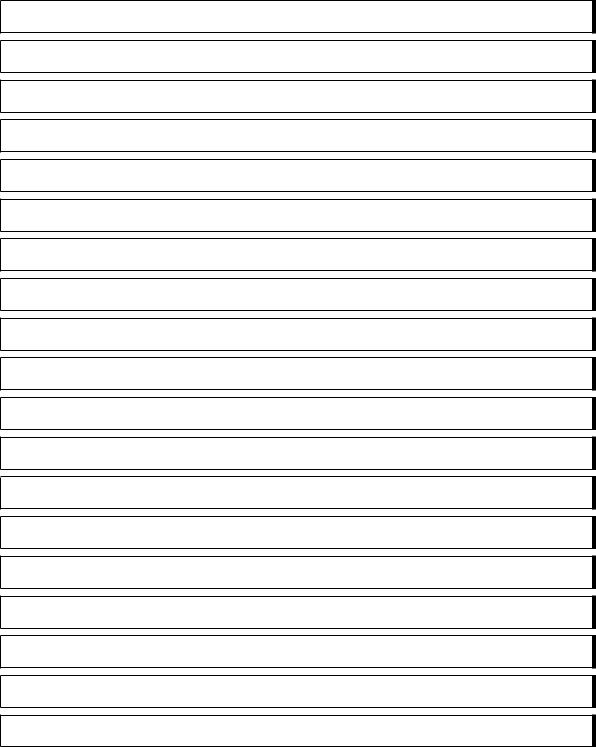
SECTION INDEX
NAME |
SECTION |
|
|
|
|
|
|
|
GENERAL |
0 |
|
|
|
|
BATTERY |
1 |
|
|
|
|
CHARGER (OPT) |
2 |
|
|
|
|
CONTROLLER |
3 |
|
|
|
|
MULTI-DISPLAY FUNCTIONS |
4 |
|
|
|
|
TROUBLESHOOTING |
5 |
|
|
|
|
MOTOR |
6 |
|
|
|
|
DRIVE UNIT & FRONT AXLE |
7 |
|
|
|
|
REAR AXLE |
8 |
|
|
|
|
STEERING |
9 |
|
|
|
|
BRAKE |
10 |
|
|
|
|
BODY & FRAME |
11 |
|
|
|
|
MATERIAL HANDLING SYSTEM |
12 |
|
|
|
|
MAST |
13 |
|
|
|
|
CYLINDER |
14 |
|
|
|
|
OIL PUMP |
15 |
|
|
|
|
OIL CONTROL VALVE |
16 |
|
|
|
|
SAS FUNCTIONS (OPT) |
17 |
|
|
|
|
APPENDIX |
18 |
|
|
|
|
0-1
GENERAL
|
Page |
VEHICLE EXTERIOR VIEW........... |
0-2 |
VEHICLE MODELS ...................... |
0-3 |
FRAME NUMBER ......................... |
0-3 |
HOW TO USE THIS MANUAL ...... |
0-4 |
EXPLANATION METHOD.................. |
0-4 |
TERMINOLOGY ................................. |
0-5 |
ABBREVIATIONS .............................. |
0-5 |
SI UNITS ............................................. |
0-6 |
OPERATING TIPS......................... |
0-7 |
GENERAL INSTRUCTIONS .............. |
0-7 |
JACK-UP POINT ................................ |
0-8 |
HOISTING THE VEHICLE.................. |
0-9 |
WIRE ROPE SUSPENSION ANGLE |
|
LIST .............................................. |
0-10 |
SAFE LOAD FOR EACH WIRE ROPE |
|
SUSPENSION ANGLE................. |
0-10 |
MEMBER WEIGHTS......................... |
0-11 |
TOWING THE VEHICLE................... |
0-11 |
ELECTRICAL PARTS |
|
INSPECTION................................. |
0-12 |
NOTES ON SAS............................... |
0-14 |
STANDARD BOLT & NUT |
|
TIGHTENING TORQUE............ |
0-15 |
BOLT STRENGTH CLASS |
|
IDENTIFICATION METHOD......... |
0-15 |
TIGHTENING TORQUE TABLE ....... |
0-16 |
PRECOATED BOLTS......................... |
0-17 |
|
Page |
|
HIGH PRESSURE HOSE FITTING |
|
|
TIGHTENING TORQUE |
0-17 |
0 |
|
||
RECOMMENDED LUBRICANT |
|
|
QUANTITY AND TYPES ......... |
0-18 |
|
LUBRICATION CHART .............. |
0-19 |
|
PERIODIC MAINTENANCE ....... |
0-20 |
|
PERIODIC REPLACEMENT OF |
|
|
PARTS AND LUBRICANTS .... |
0-25 |
|
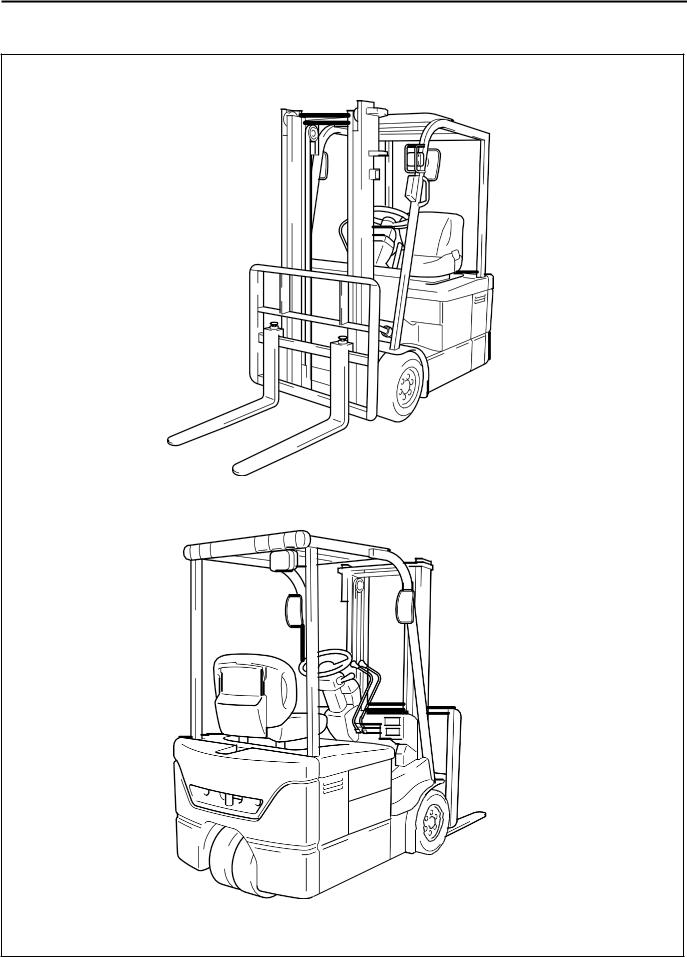
0-2
VEHICLE EXTERIOR VIEW
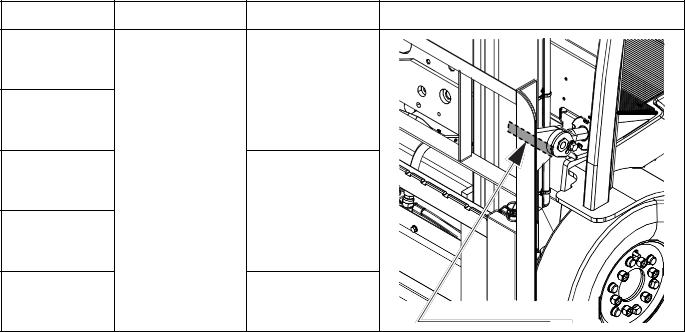
|
|
|
|
0-3 |
|
|
|
VEHICLE MODELS |
|
|
|
|
|
|
|
|
|
|
|
|
|
|
|
Vehicle model code |
Payload (ton) |
Vehicle Model |
Control method |
Voltage (V) |
|
|
|
|
|
|
|
|
|
|
|
10 |
1.0 |
7FBE10 |
AC microcomputer controller |
48 |
|
|
|
|
|
|
|
|
|
|
|
13 |
1.25 |
7FBE13 |
|
|
|
|
|
|
|
|
|
|
|
|
|
15 |
1.5 |
7FBE15 |
|
|
|
|
|
|
0 |
||||||
|
|
|
|
|
|
|
|
18 |
1.75 |
7FBE18 |
|
|
|
|
|
|
|
|
|||||
|
|
|
|
|
|
|
|
20 |
2.0 |
7FBE20 |
|
|
|
|
|
|
|
|
|
|
|
|
|
FRAME NUMBER
Vehicle model |
Drive motor model Punching format |
Punching position |
7FBE10 |
|
|
|
7FBE13-50011 |
|
7FBE13 |
|
|
7FBE15 |
AR09 |
|
|
7FBE18-50011 |
|
7FBE18 |
|
|
7FBE20 |
7FBE20-50011 |
|
|
|
Punching position |
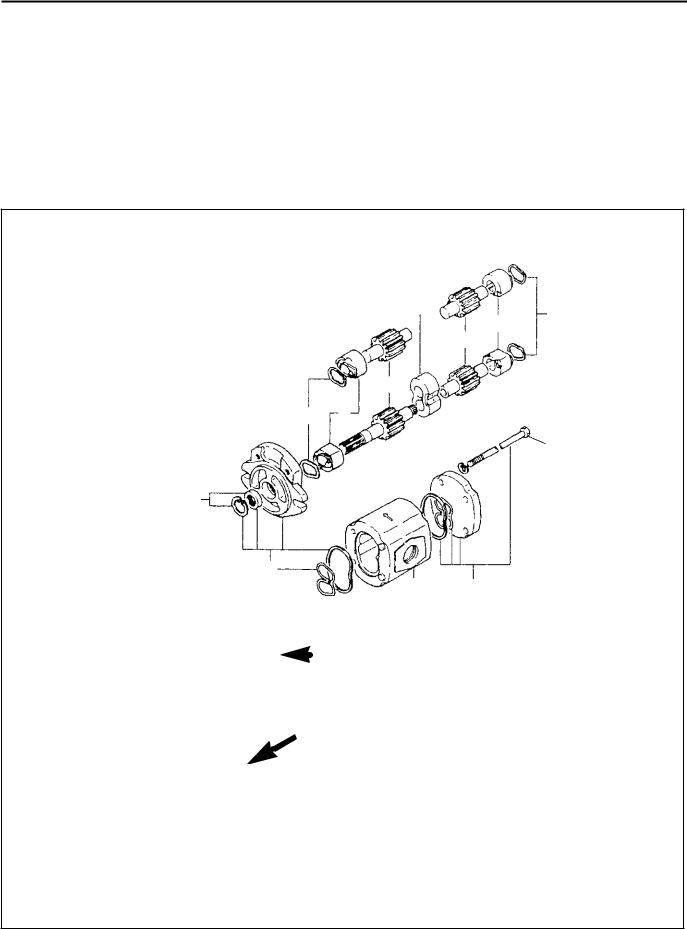
0-4
HOW TO USE THIS MANUAL
EXPLANATION METHOD
1.Operating procedure
(1)Operating procedures are described using either pattern A or pattern B. Pattern A: Each step of the operation is explained with its own illustration.
Pattern B: The entire operation is indicated by step numbers in one illustration, followed by cautions, notes, and point operations.
Example of pattern B
DISASSEMBLY · INSPECTION · REASSEMBLY
|
|
|
Tightening torque unit T=N·m(kg·m)[ft·lbf] |
||
|
|
|
|
|
|
|
• Some step numbers may be |
4 |
1 |
|
|
|
omitted in some illustrations. |
|
|
|
|
|
|
|
2 |
|
|
|
|
|
|
3 |
|
|
|
7 |
|
|
|
|
5 |
6 |
|
|
|
|
|
|
|
T = 46.1 to 48.1 |
|
|
|
|
|
(470 to 490) |
|
|
|
|
|
[34.0 to 35.5] |
|
|
8 |
|
|
|
|
|
5 |
|
|
|
|
|
|
9 |
1 |
|
|
|
|
|
|
|
|
Disassembly Procedure |
|
|
|
|
|
1 Remove the cover. [Point 1] |
|
Operation to be explained |
|||
|
|||||
2 Remove the bushing. [Point 2] |
|
|
|
|
|
3 Remove the gear. |
|
|
|
|
|
Point Operations
Explanation of operation point with illustration
[POINT 1]
Disassembly:
Make match marks before removing the pump cover
[POINT 2]
Inspection:
Measure the bushing inside diameter.
Limit 19.12 mm

0-5
1. How to read component figures |
(Example) |
|
(1) The component figures use the illustration in the parts |
|
|
|
3201 |
|
catalog for the vehicle model. Please refer to the catalog |
|
|
|
|
|
to check the part name. |
Parts catalog |
|
|
FIG number |
|
2.Matters omitted from this manual
(1)This manual omits descriptions of the following jobs, but perform them in actual operation:
(a)Cleaning and washing of removed parts as required
(b) |
Visual inspection (partially described) |
|
0 |
|
|||
|
|
|
|
|
|
|
|
TERMINOLOGY
CAUTION:
Important matters, negligence of which may cause accidents. Be sure to observe them.
NOTE:
Important items, negligence of which may cause accidents, or matters in operating procedure which require special attention.
Standard: Value showing the allowable range in inspection or adjustment
Limit: The maximum or minimum value allowed in inspection or adjustment.
ABBREVIATIONS
Abbreviation |
Meaning |
Abbreviation |
Meaning |
|
|
|
|
|
|
ASSY |
Assembly |
SAE |
Society of Automotive Engineers |
|
(USA) |
||||
|
|
|
||
|
|
|
|
|
ATT |
Attachment |
SAS |
System of active stability |
|
|
|
|
|
|
LH |
Left Hand |
SST |
Special Service Tool |
|
|
|
|
|
|
L/ |
Less |
STD |
Standard |
|
|
|
|
|
|
OPT |
Option |
T= |
Tightening Torque |
|
|
|
|
|
|
O/S |
Oversize |
T |
Number of teeth (T) |
|
PS system |
Power Steering |
U/S |
Undersize |
|
|
|
|
|
|
RH |
Right Hand |
W/ |
With |
|
|
|
|
|

0-6
SI UNITS
Meaning of SI
This manual uses SI units. SI represents the International System of Units, which was established to unify the various systems of units used in the past for smoother international technical communication.
New Units Adopted in SI
Item |
New unit |
Conventional |
Conversion rate*1 (1 [conventional unit] = X [SI |
|
unit |
unit]) |
|||
|
|
|||
Force*2 |
N (newton) |
kgf |
1 kgf = 9.80665 N |
|
|
|
|
|
|
Torque*2 |
N·m |
kgf·cm |
1 kgf·cm = 9.80665 N·m |
|
(Moment) |
||||
|
|
|
||
|
|
|
|
|
Pressure*2 |
Pa (pascal) |
kgf/cm2 |
1 kgf/cm2 = 98.0665 kPa = 0.0980665 MPa |
|
|
|
|
|
|
|
|
mmHg |
1 mmHg = 0.133322 kPa |
|
|
|
|
|
|
Revolving speed |
rpm |
rpm |
1 rpm = 1 r/min |
|
|
|
|
|
|
Spring con- |
N/mm |
kgf/mm |
1 kgf/mm = 9.80665 N/mm |
|
|
|
|
|
|
Volume |
l |
cc |
1 cc = 1 ml |
|
|
|
|
|
|
Power |
W |
PS system |
1 PS = 0.735499 kW |
|
|
|
|
|
|
Heat quantity |
W·h |
cal |
1 kcal = 1.16279 W·h |
|
|
|
|
|
|
Specific fuel |
g/W·h |
g/PS·h |
1 g/PS·h = 1.3596 g/kW·h |
|
|
|
|
|
<Reference>
*1: X represents the value in SI units as converted from 1 [in conventional units], which can be used as the rate for conversion between conventional and SI units.
*2: In the past, kilogram [kg] representing mass was often used in place of weight kilogram [kgf], which should be used as the unit of force.
Conversion between Conventional and SI Units
Equation for conversion
Value in SI unit = Conversion rate Value in conventional unit |
Conversion rate: Figure corresponding |
|
|
to X in the conversion rate column in |
|
Value in conventional unit = Value in SI unit Conversion rate |
||
the table above |
||
|
||
|
|
When converting, change the unit of the value in conventional or SI units to the one in the conversion rate column in the table above before calculation. For example, when converting 100 W to the value in conventional unit PS, first change it to 0.1 kW and divide by the conversion rate 0.735499.

0-7
OPERATING TIPS
GENERAL INSTRUCTIONS
1.Skillful operation
(1)Prepare the tools, necessary measuring instruments (circuit tester, megohmmeter, oil pressure gauge, etc.) and SSTs before starting operation.
(2)Check the cable color and wiring state before disconnecting any wiring.
(3)When overhauling functional parts, complicated sections or related mechanisms, arrange the parts neatly to prevent confusion.
(4)When disassembling and inspecting a precision part such as the control valve, use clean tools and operate in a clean location.
(5)Follow the specified procedures for disassembly, inspection and reassembly.
(6)Always replace gaskets, packing, O-rings, self-locking nuts and cotter pins with new oneseach time they are disassembled.
(7)Use genuine Toyota parts for replacement.
(8)Use specified bolts and nuts and observe the specified tightening torque when reassembling. (Tighten to the medium value of the specified tightening torque range.) If no tightening torque is specified, use the value given in the “standard tightening torque table”.
2.Protection of functional parts (battery operated vehicles)
(1)Before connecting the battery plug after vehicle inspection or maintenance, thoroughly check each connector for any connection failure or imperfect connection.
Failure or imperfect connection of connectors related to controllers, especially, may damage elements inside the controllers.
3.Defect status check
Do not start disassembly and/or replacement immediately, but first check that disassembly and/or replacement is necessary for the defect.
4.Waste fluid disposal
Always use a proper container when draining waste fluid from the vehicle.
Careless discharge of oil, fuel, coolant, oil filter, battery or other harmful substance may adversely affect human health and the environment. Always collect and sort well, and ask specialized companies for appropriate disposal.

0-8
JACK-UP POINT
Always observe the following instructions when jacking up the vehicle:
•When the fork is loaded, unload it and park the vehicle on a flat surface. Be sure to avoid an inclined or rough surface.
•Use a jack with ample capacity and jack up the vehicle at the specified jack-up point. Jacking up at any other point is dangerous.
•Always support the load of jacked-up vehicle with wooden blocks at specified points. Supporting the vehicle with the jack only is very dangerous.
•Never, under any circumstances, put any part of the body (including hands and feet) under the jacked-up vehicle.
Jack-up point
Wooden block or stand setting points
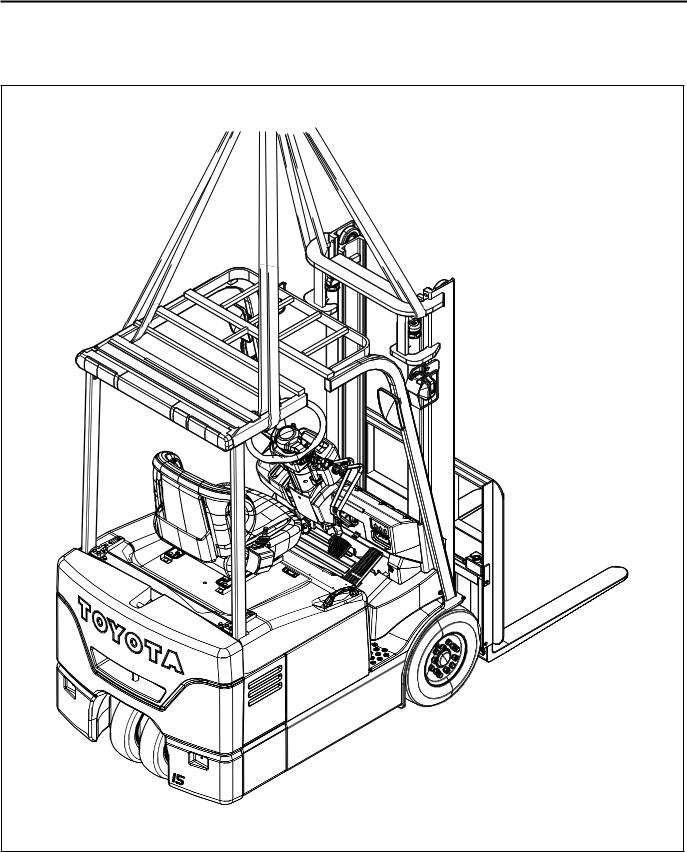
0-9
HOISTING THE VEHICLE
When hoisting the vehicle, always observe the specified hoist attachment section and method. Never hoist by any other attachment section as it is very dangerous.
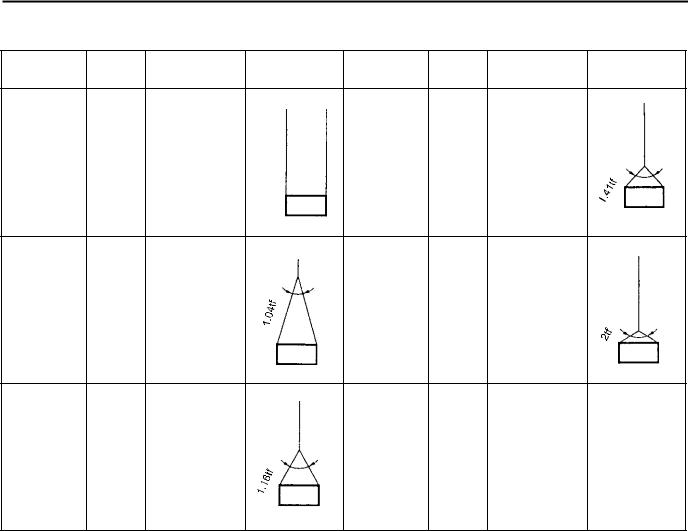
0-10
WIRE ROPE SUSPENSION ANGLE LIST
Suspension |
Tension Compression |
Suspension |
Angle |
|
method |
0 |
1.00 |
0 time |
1tf |
|
time |
||||
|
|
|
2t
30
30 |
1.04 |
0.27 time |
|
time |
|||
|
|
2t
60 |
1.16 |
0.58 time |
60 |
time |
|
||
|
|
|
|
|
|
|
2t |
Suspension |
Tension Compression |
Suspension |
Angle |
|
method |
90 |
1.41 |
1.00 time |
90 |
|
time |
||||
|
|
|
||
|
|
|
2t |
120 |
2.00 |
1.73 time |
|
|
time |
120 |
|||
|
|
|||
|
|
|
2t |
SAFE LOAD FOR EACH WIRE ROPE SUSPENSION ANGLE
Unit: N (tf) [lbf]
Rope |
Cutting |
Single- |
Two-rope suspension |
four-rope suspension |
|||||||
rope |
|||||||||||
diameter |
load |
|
|
|
|
|
|
|
|
||
0 |
0 |
30 |
60 |
90 |
0 |
30 |
60 |
90 |
|||
|
|
||||||||||
|
|
|
|
|
|
|
|
|
|
|
|
6 mm |
21380 |
3040 |
6080 |
5880 |
5200 |
4310 |
12160 |
11770 |
10400 |
8630 |
|
(2.18) |
(0.31) |
(0.62) |
(0.6) |
(0.53) |
(0.44) |
(1.24) |
(1.2) |
(1.06) |
(0.88) |
||
(0.24 in) |
|||||||||||
[4807] |
[683.6] |
[1367] |
[1323] |
[1169] |
[970] |
[2734] |
[2646] |
2337 |
[1940] |
||
|
|||||||||||
|
|
|
|
|
|
|
|
|
|
|
|
8 mm |
31480 |
4410 |
8830 |
8530 |
7650 |
6280 |
17650 |
17060 |
15300 |
12550 |
|
(3.21) |
(0.45) |
(0.9) |
(0.87) |
(0.78) |
(0.64) |
(1.8) |
(1.74) |
(1.56) |
(1.28) |
||
(0.32 in) |
|||||||||||
[7078] |
[992.3] |
[1985] |
[1918] |
[1720] |
[1411] |
[3969] |
[3937] |
[3440] |
[2322] |
||
|
|||||||||||
|
|
|
|
|
|
|
|
|
|
|
|
10 mm |
49230 |
6960 |
14020 |
13440 |
11770 |
9810 |
27460 |
26480 |
23540 |
19610 |
|
(5.02) |
(0.71) |
(1.43) |
(1.37) |
(1.2) |
(1.0) |
(2.8) |
(2.7) |
(2.4) |
(2.0) |
||
(0.4 in) |
|||||||||||
[11690] |
[1565.6] |
[3153] |
[3021] |
[2646] |
[2205] |
[6174] |
[5954] |
[5292] |
[4410] |
||
|
|||||||||||
|
|
|
|
|
|
|
|
|
|
|
|
12.5 mm |
76880 |
10980 |
21570 |
21280 |
18630 |
14710 |
43150 |
41190 |
37270 |
29420 |
|
(7.84) |
(1.12) |
(2.2) |
(2.1) |
(1.9) |
(1.5) |
(4.4) |
(4.2) |
(3.8) |
(3.0) |
||
(0.5 in) |
|||||||||||
[17387] |
[2469.5] |
[4851] |
[4631] |
[4190] |
[3308] |
[9702] |
[9261] |
[8379] |
[6615] |
||
|
|||||||||||
|
|
|
|
|
|
|
|
|
|
|
|
14 mm |
96400 |
13730 |
27460 |
26480 |
23540 |
18630 |
54920 |
52960 |
47070 |
37270 |
|
(9.83) |
(1.4) |
(2.8) |
(2.7) |
(2.4) |
(1.9) |
(5.6) |
(5.4) |
(4.8) |
(3.8) |
||
(0.56 in) |
|||||||||||
[21675] |
[3087] |
[6174] |
[5954] |
[5292] |
[4190] |
[12348] |
[11907] |
[10584] |
[8379] |
||
|
|||||||||||
|
|
|
|
|
|
|
|
|
|
|
|
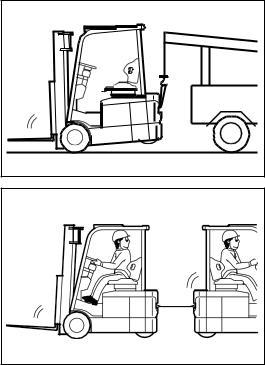
|
|
|
|
|
0-11 |
|
MEMBER WEIGHTS |
|
|
|
|
|
|
|
|
|
Unit: kg (lbs) |
|||
Member |
Vehicle model |
|
Weight |
|
|
|
|
|
|
|
|
|
|
BATTERY ASSY |
|
See P1-2 |
|
|
|
|
|
|
|
|
|
|
|
Drive motor ASSY |
All Models |
|
Approx. 37 |
(82) |
|
|
|
|
|
|
|
|
|
Pump motor ASSY |
All Models |
|
Approx. 31 |
(68) |
|
|
|
|
|
|
|
|
|
Front axle ASSY W/ drive motor ASSY |
All Models |
|
Approx. 122 |
(269) |
|
|
|
|
|
|
|
|
|
Rear axle ASSY W/ rear axle cylinder ASSY |
All Models |
|
Approx. 45 |
(99) |
|
|
|
|
|
|
|
|
|
|
7FBE10 |
|
Approx. 405 |
(893) |
|
|
|
|
|
|
|
||
|
7FBE13 |
|
Approx. 598 (1319) |
|
||
Counterweight |
|
|
|
|
||
7FBE15 |
|
Approx. 697 (1537) |
|
|||
|
|
|
|
|
||
|
7FBE18 |
|
Approx. 853 (1881) |
|
||
|
|
|
|
|
|
|
|
7FBE20 |
|
Approx. 1040 |
(2293) |
|
|
|
|
|
|
|
|
|
Mast ASSY W/ lift bracket (W/ lift cylinder, L/ fork, |
7FBE10 to 7FBE18 |
|
330 |
(730) |
|
|
Lifting height 3000mm, V mast) |
|
|
|
|
|
|
7FBE20 |
|
400 |
(880) |
|
||
|
|
|
||||
|
|
|
|
|
|
|
|
7FBE10 |
|
2225 |
(4906) |
|
|
|
|
|
|
|
|
|
|
7FBE13 |
|
2425 |
(5347) |
|
|
Vehicle weight |
|
|
|
|
|
|
7FBE15 |
|
2685 |
(5920) |
|
||
|
|
|
|
|
|
|
|
7FBE18 |
|
2840 |
(6262) |
|
|
|
|
|
|
|
|
|
|
7FBE20 |
|
3155 |
(6957) |
|
|
|
|
|
|
|
|
|
TOWING THE VEHICLE
Note the cautions below when towing the vehicle.
1. Lift the rear wheels for towing
2. The traveling speed when towing must not exceed the maximum traveling speed of the forklift.
3. Before starting towing, always set the key switch to OFF and the direction switch to the neutral position.
4. Before towing, either remove the fork or take action to prevent the fork from coming into contact with the ground due to bouncing.
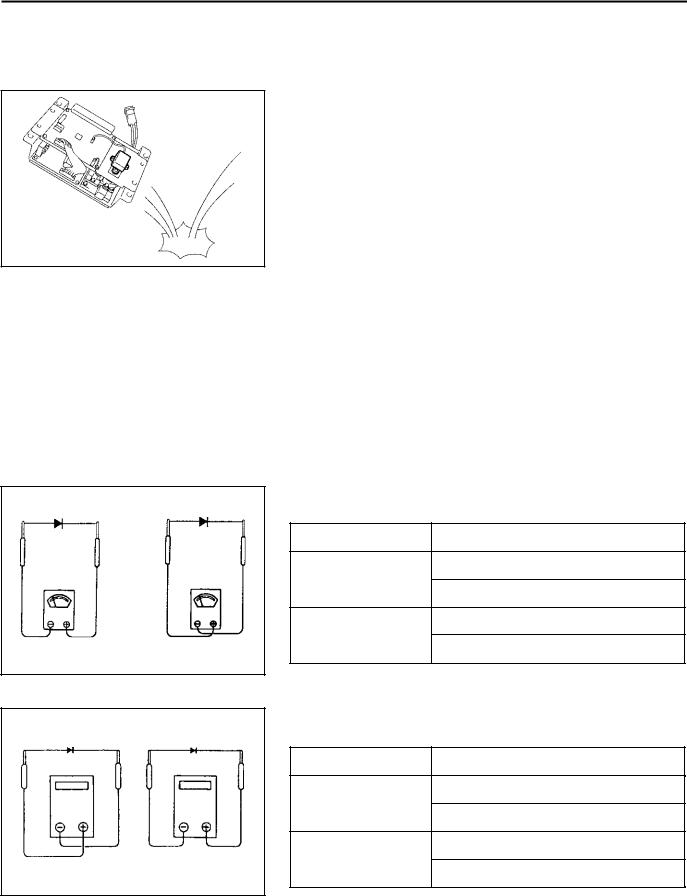
0-12
ELECTRICAL PARTS INSPECTION
1.Always disconnect the battery plug before inspecting or servicing electrical parts.
2.Pay sufficient attention when handling electronic parts.
(1)Never subject electronic parts, such as computers and relays, to impact.
(2)Never expose electronic parts to high temperature or moisture.
(3)Do not touch connector terminals, as they may be deformed or damaged due to static electricity.
3.Use a circuit tester that matches the object and purpose of measurement.
Analog type: This type is convenient for observing movement during operation and the operating condition. Measured value is only a reference
Digital type: A fairly accurate reading is possible. However, it is difficult to observe operation or movement.
(1)Difference between results of measurement with analog and digital types
The results of measurements using the analog type and the digital type may be different. Differences between the polarities of the analog type and the digital type are described below.
1)Analog circuit tester
Forward |
Reverse |
2)Digital circuit tester
Forward |
Reverse |
Example of measurement result
Tester range: k range
Analog type
Continuity
Forward
11 k
No continuity
Reverse
Example of measurement result
Tester range: 2 M range
Digital type
No continuity
Forward
1
Continuity
Reverse
2 M
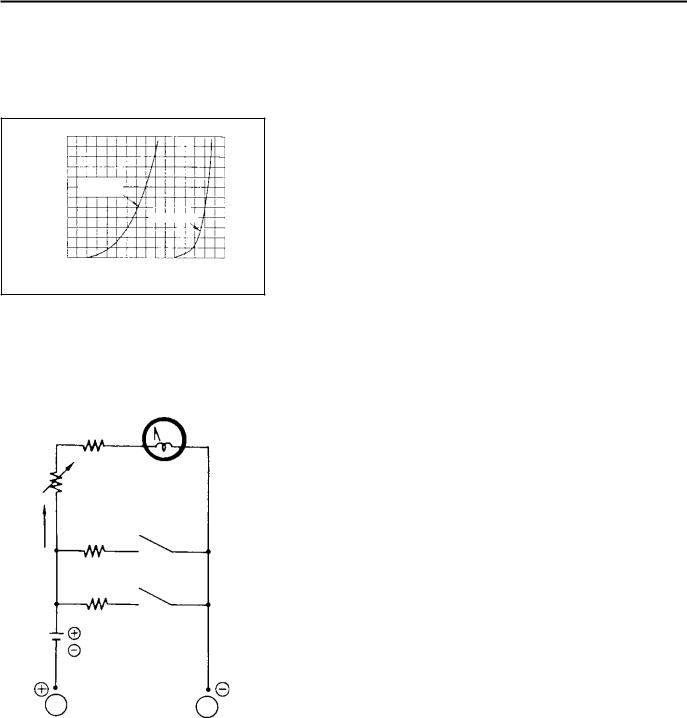
0-13
(2)Difference in result of measurement with a circuit tester
The circuit tester power supply voltage depends on the tester type. 1.5 V, 3.0 V or 6.0 V is used. The resistance of a semiconductor, such as a diode, varies with the circuit tester power supply voltage.
The diode characteristics are shown in the figure below.
(mA)
Forward current
6 |
|
|
5 |
|
|
4 |
Germanium |
|
|
|
|
3 |
diode |
|
|
|
|
2 |
Silicon |
|
diode |
|
|
|
|
|
1 |
|
|
0 |
0.1 0.2 0.3 0.4 0.5 0.6 0.7 0.8 |
|
|
||
|
Forward voltage |
(V) |
The resistance values of the same semiconductor measured with two types of circuit testers having different power supply voltages are different.
This manual describes the results of measurement with a circuit tester whose power supply voltage is 3.0 V.
(3)Difference in measurement result by measurement range (analog type)
In the analog type circuit tester, changing the measurement range switches over the internal circuit to vary the circuit resistance. Even when the same diode is measured, the measurement result varies with the measurement range.
|
Resistor |
Meter |
|
0 |
|
flow |
Variable resistor |
|
|
|
|
Current |
Resistor |
|
|
|
|
|
Range: 10 |
(SW1) |
|
|
|
|
Resistor |
|
|
Range: 1 |
|
|
Power source: 1.5V |
|
|
Red |
Black |
|
|
|
Always use the range described in the repair manual for measurement.

0-14
NOTES ON SAS
1.For the explanations of SAS functions and operation, also see “New Model Feature 7FBE10 to 20 Pub.
No.PE314”.
2.See page 17-6 FOR REPAIR WORK of this repair manual before servicing.
3.If repair or replacement is performed in any section of the vehicle that relates to SAS function, perform necessary matching to ensure proper SAS function (see page 4-47).
4.always be sure to operate the vehicle carefully. Be aware of the difference in control features between with and without SAS.
5.Many precision valves are used in the SAS oil control valves. When disassembling or replacing hydraulic parts (valves, piping, etc.), be sure to clean the parts before installation. Periodic change of the hydraulic oil is also very important.
6.As the vehicle is equipped with high-precision electronic devices, modification of electrical parts may cause vehicle failure. Be sure to use genuine Toyota parts for replacement and installation of the electrical parts (auxiliary equipment, optional parts, etc.).
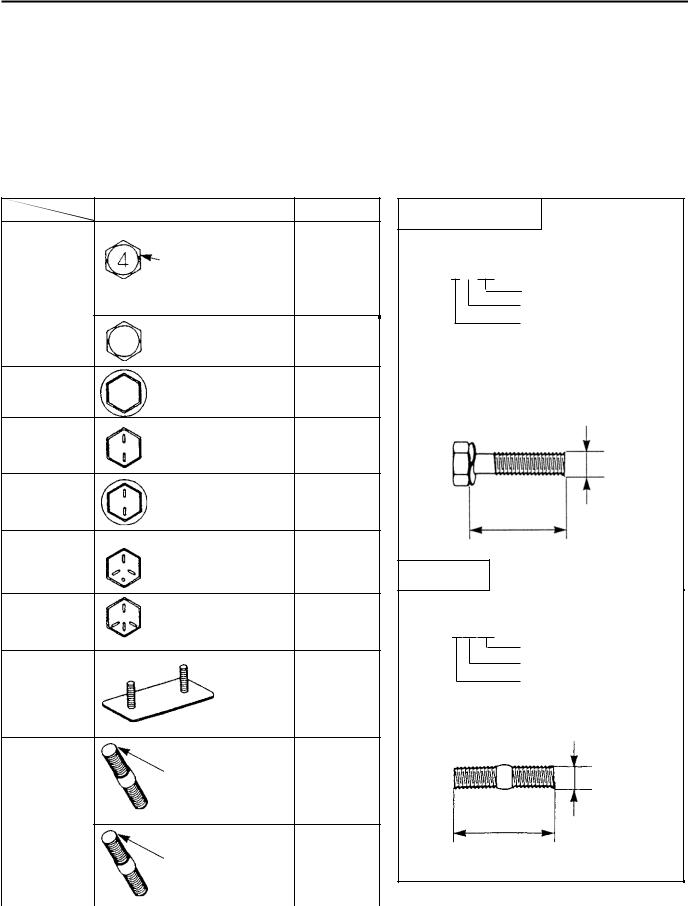
0-15
STANDARD BOLT & NUT TIGHTENING TORQUE
Tightening torque of standard bolts and nuts are not indicated throughout the manual. Use the charts and table below to judge the standard tightening torque.
1.Find the class of the bolt strength on the table below and then find the bolt tightening torque on the tightening torque table.
2.The nut tightening torque can be judged from its corresponding bolt type.
BOLT STRENGTH CLASS IDENTIFICATION METHOD
Identification by bolt shape |
Identification by part No. |
|
Shape and class |
Class |
Hexagon head bolt |
|
|
|
|
||
Hexagon |
|
4 = 4T |
|
|
Bolt with raised |
5 = 5T |
Part No. |
||
head bolt |
||||
or etched |
||||
|
6 = 6T |
91611-40625 |
||
Hexagon |
numeral on head |
7 = 7T |
Length (mm) |
|
|
8 = 8T |
Nominal diameter (mm) |
||
bolt |
|
|||
|
|
|
Class |
|
(standard) |
No mark |
4T |
|
|
|
|
|
||
Hexagon |
No mark |
4T |
|
|
flange bolt |
|
|||
|
|
|
||
Hexagon |
Bolt with two |
|
|
|
head bolt |
raised lines on |
5T |
|
|
(standard) |
head |
|
Nominal diameter |
|
Hexagon |
Bolt with two |
|
|
|
raised lines on |
6T |
|
||
flange bolt |
Length |
|||
head |
|
|||
|
|
|||
|
|
|
||
Hexagon |
Bolt with three |
|
|
|
head bolt |
raised lines on |
7T |
|
|
(standard) |
|
Stud bolt |
||
head |
|
|||
|
|
|
||
Hexagon |
Bolt with four |
|
Part No. |
|
head bolt |
raised lines on |
8T |
||
92132-40614 |
||||
(standard) |
head |
|
||
|
Length (mm) |
|||
|
|
|
||
|
|
|
Nominal diameter (mm) |
|
Welded bolt |
|
4T |
Class |
|
|
|
|||
|
No mark |
4T |
Nominal diameter |
|
Stud bolt |
|
|
Length |
|
|
|
|
||
|
2 mm groove(s) |
|
|
|
|
on one/both |
6T |
|
|
|
edge(s) |
|
|

0-16
TIGHTENING TORQUE TABLE
|
|
|
|
|
Standard tightening torque |
|
|
|||
|
|
|
|
|
|
|
|
|
|
|
|
Nominal |
|
Hexagon |
|
|
|
Hexagon |
|
|
|
|
Pitch |
head bolt |
|
|
|
|
|
|||
Class |
diameter |
|
|
|
flange bolt |
|
|
|||
mm |
|
|
|
|
|
|||||
|
mm |
|
|
|
|
|
|
|
|
|
|
|
|
|
|
|
|
|
|
|
|
|
|
|
|
|
|
|
|
|
|
|
|
|
|
N·m |
kgf·cm |
|
ft·lbf |
N·m |
|
kgf·cm |
ft·lbf |
|
|
|
|
|
|
|
|
|
|
|
|
6 |
1.0 |
5.4 |
55 |
|
48in·lbf |
5.9 |
|
60 |
52in·lbf |
|
8 |
1.25 |
13 |
130 |
|
9 |
14 |
|
145 |
10 |
4T |
10 |
1.25 |
25 |
260 |
|
19 |
28 |
|
290 |
21 |
12 |
1.25 |
47 |
480 |
|
35 |
53 |
|
540 |
39 |
|
|
|
|
||||||||
|
14 |
1.5 |
75 |
760 |
|
55 |
83 |
|
850 |
61 |
|
16 |
1.5 |
113 |
1150 |
|
83 |
|
|
|
|
|
|
|
|
|
|
|
|
|
|
|
|
6 |
1.0 |
6.4 |
65 |
|
56in·lbf |
7.5 |
|
75 |
65in·lbf |
|
8 |
1.25 |
16 |
160 |
|
12 |
18 |
|
175 |
13 |
5T |
10 |
1.25 |
32 |
330 |
|
24 |
36 |
|
360 |
26 |
12 |
1.25 |
59 |
600 |
|
43 |
65 |
|
670 |
48 |
|
|
|
|
||||||||
|
14 |
1.5 |
91 |
930 |
|
67 |
100 |
|
1050 |
76 |
|
16 |
1.5 |
137 |
1400 |
|
101 |
157 |
|
1600 |
116 |
|
|
|
|
|
|
|
|
|
|
|
|
6 |
1.0 |
7.8 |
80 |
|
69in·lbf |
8.8 |
|
90 |
78in·lbf |
|
8 |
1.25 |
19 |
195 |
|
14 |
21 |
|
215 |
16 |
6T |
10 |
1.25 |
38 |
400 |
|
29 |
43 |
|
440 |
32 |
12 |
1.25 |
72 |
730 |
|
53 |
79 |
|
810 |
59 |
|
|
|
|
||||||||
|
14 |
1.5 |
110 |
1100 |
|
80 |
123 |
|
1250 |
90 |
|
16 |
1.5 |
170 |
1750 |
|
127 |
191 |
|
1950 |
141 |
|
|
|
|
|
|
|
|
|
|
|
|
6 |
1.0 |
11 |
110 |
|
8 |
12 |
|
120 |
9 |
|
8 |
1.25 |
25 |
260 |
|
19 |
28 |
|
290 |
21 |
7T |
10 |
1.25 |
52 |
530 |
|
38 |
58 |
|
590 |
43 |
12 |
1.25 |
95 |
970 |
|
70 |
103 |
|
1050 |
76 |
|
|
|
|
||||||||
|
14 |
1.5 |
147 |
1500 |
|
108 |
167 |
|
1700 |
123 |
|
16 |
1.5 |
226 |
2300 |
|
166 |
|
|
|
|
|
|
|
|
|
|
|
|
|
|
|
|
6 |
1.0 |
12 |
125 |
|
9 |
14 |
|
145 |
9 |
|
8 |
1.25 |
29 |
300 |
|
22 |
32 |
|
330 |
24 |
8T |
10 |
1.25 |
61 |
620 |
|
45 |
68 |
|
690 |
50 |
12 |
1.25 |
108 |
1100 |
|
80 |
123 |
|
1250 |
90 |
|
|
|
|
||||||||
|
14 |
1.5 |
172 |
1750 |
|
127 |
196 |
|
2000 |
145 |
|
16 |
1.5 |
265 |
2700 |
|
195 |
299 |
|
3050 |
221 |
|
|
|
|
|
|
|
|
|
|
|
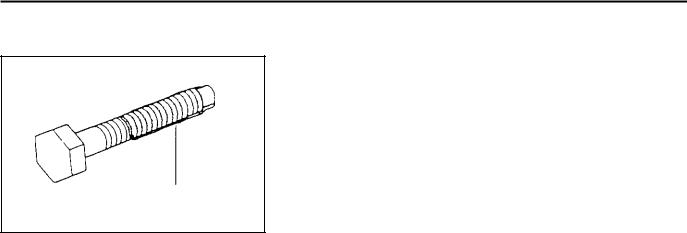
0-17
PRECOATED BOLTS
Seal lock agent
1.Do not replace or restore a precoated bolt as it is in the following cases:
(1)After it has been removed.
(2)When it has been moved by tightness check, etc.
(loosened or tightened)
NOTE:
For torque check, tighten the bolt at the lower limit of the allowable tightening torque range; if the bolt moves, retighten it according to the steps below.
2.How to reuse precoated bolts
(1)Wash the bolt and threaded hole.
(The threaded hole must be washed even when replacing the bolt with a new one)
(2)Completely dry the washed parts by blowing with air.
(3)Apply a specified seal lock agent to the threaded portion of the bolt.
HIGH PRESSURE HOSE FITTING TIGHTENING TORQUE
1.When connecting a high pressure hose, wipe the hose fitting and corresponding nipple contact surfaces with a clean cloth to remove foreign matter and dirt. Also check that there are no dents or other damage on the contact surfaces before installation.
2.When connecting the high pressure hose, hold the hose to align the fitting with the nipple and tighten the fitting.
3.The maximum tightening torque must not exceed twice the standard tightening torque.
Nominal diameter |
|
Tightening torque standard N·m (kgf·cm) [ft·lbf] |
Inside diameter |
|||
|
|
|
|
|
of hose |
|
of screw |
|
|
|
|
|
|
|
Standard |
|
Tightening range |
|||
|
|
mm (in) |
||||
|
|
|
||||
|
|
|
|
|
|
|
7/16-20UNF |
25 (50) [18.1] |
24 to 26 (240 to 270) [17.4 to 19.5] |
6 (0.24) |
|||
9/16-18UNF |
49 |
(500) [36.2] |
47 to 52 (480 to 530) [34.7 to 38.3] |
9 (0.35) |
||
3/4-16UNF |
59 |
(600) [43.4] |
56 to 62 |
(570 to 630) [41.2 to 45.6] |
12 (0.47) |
|
7/8-14UNF |
59 |
(600) [43.4] |
56 to 62 |
(570 to 630) [41.2 to 45.6] |
12 (0.47) |
|
7/8-14UNF |
78 |
(800) [57.9] |
74 to 82 |
(740 to 840) |
[53.5 to 60.8] |
15 (0.59) |
1•1/16-12UNF |
118 |
(1200) [86.8] |
112 to 123 |
(1140 to 1250) [82.5 to 90.4] |
19 (0.75) |
|
1•5/16-12UNF |
137 (1400) [101.3] |
130 to 144 (1330 to 1470) [96.2 to 106.4] |
25 (0.98) |
|||
|
|
|
|
|
|
|
PF1/4 |
25 |
(250) [18.1] |
24 to 26 (240 to 270) |
[17.4 to 19.5] |
6 (0.24) |
|
PF3/8 |
49 |
(500) [36.2] |
47 to 52 (480 to 530) |
[34.7 to 38.3] |
9 (0.35) |
|
PF1/2 |
59 |
(600) [43.4] |
56 to 62 (570 to 630) |
[41.2 to 45.6] |
12 (0.47) |
|
PF3/4 |
118 |
(1200) [86.8] |
112 to 123 |
(1140 to 1250) [82.5 to 90.4] |
19 (0.75) |
|
PF1 |
137 (1400) [101.3] |
130 to 144 (1330 to 1470) [96.2 to 106.4] |
25 (0.98) |
|||
|
|
|
|
|
|
|

0-18
RECOMMENDED LUBRICANT QUANTITY AND TYPES
Application |
|
|
|
Type |
|
|
Capacity |
||
|
|
|
|
|
|
|
|
|
|
Drive unit |
|
Castle hypoid gear oil W |
|
|
Approx. 0.4 l (0.11 US gal) |
||||
|
(API GL-4, SAE 75W-80) |
|
(Until purring out from the filler port) |
||||||
|
|
|
|
||||||
|
|
|
|
|
|
|
|
|
|
Hydraulic oil |
|
STD: Castle hydraulic oil (ISO VG32) |
See “Hydraulic oil level by lifting |
||||||
|
|
|
Cold storage vehicle: Mobil Aero HFE |
height” below |
|
||||
|
|
|
|
|
|
|
|
|
|
|
|
|
MP grease |
|
|
|
|
|
|
Chassis parts |
|
Chassis grease special |
|
|
Appropriate amount |
||||
|
|
|
Esso beacon 325 |
|
|
|
|
|
|
|
|
|
|
|
|
|
|
|
|
Battery |
|
Distilled water |
|
|
|
Appropriate amount |
|||
|
|
|
|
|
|
|
|
|
|
Hydraulic oil level by lifting height |
|
|
|
|
|
||||
|
|
|
|
|
|
|
|
|
Unit:l (US gal) |
|
|
|
|
|
|
|
|
||
Lifting height |
|
V mast |
SV mast |
|
FV Mast |
FSV Mast |
|||
|
|
|
|
|
|
|
|
|
|
|
|
|
Capacity |
|
14 (3.70) |
14 (3.70) |
|
17 (4.49) |
|
To 3000mm |
|
|
|
|
|
|
|
|
|
|
Hydraulic oil level |
|
|
|
|
|
|
||
(118 in) |
|
|
|
12.4 (3.27) |
|
||||
|
|
in the tank |
|
|
|
||||
|
|
|
|
|
|
|
|
||
|
|
|
|
|
|
|
|
|
|
|
|
|
Capacity |
|
15 (3.96) |
15 (3.96) |
|
19 (5.01) |
16 (4.22) |
To 4000mm |
|
|
|
|
|
|
|
|
|
|
Hydraulic oil level |
|
|
|
|
|
|
||
(157.5 in) |
|
|
|
14.2 (3.75) |
|
||||
|
|
in the tank |
|
|
|
||||
|
|
|
|
|
|
|
|
||
|
|
|
|
|
|
|
|
|
|
|
|
|
Capacity |
|
18 (4.75) |
|
|
|
19 (5.01) |
To 6000mm |
|
|
|
|
|
|
|
|
|
|
Hydraulic oil level |
|
|
|
|
|
|
||
(236 in) |
|
|
|
17.2 (4.54) |
|
||||
|
|
in the tank |
|
|
|
||||
|
|
|
|
|
|
|
|
||
|
|
|
|
|
|
|
|
|
|
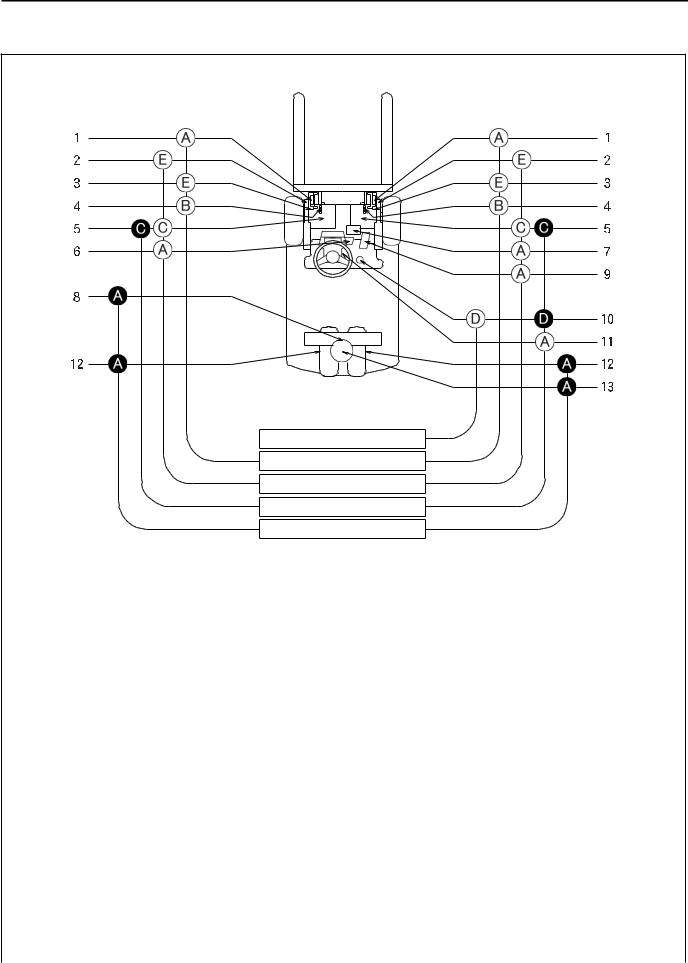
0-19
LUBRICATION CHART
|
I |
|
II |
|
III |
|
IV |
|
V |
: Inspection and addition |
I. Inspection every 8 hours (daily) |
: Replacement |
II. Inspection every 40 hours (weekly) |
A: MP grease |
III. Inspection every 170 hours (monthly) |
B: Motor oil |
IV. Inspection every 1000 hours (6 monthly) |
C: Gear oil (SAE 75W-80) |
V. Inspection 2000 hours (annual) |
D:Hydraulic oil (ISO VG32)
E:Chassis grease special
1. |
Mast strip |
8. |
Steering rack and pinion gear |
|
2. |
Tilt cylinder front pin |
9. |
Accelerator link |
|
3. |
Mast support bushing |
10. Oil tank |
||
4. |
Lift chain |
11. Tilt steering lock device |
||
5. |
Drive unit |
12. |
Rear wheel bearing |
|
6. |
Brake link |
13. |
Rear axle bearing |
|
7. |
Oil control valve lever pin |
|
|
|
|
|
|
|
|
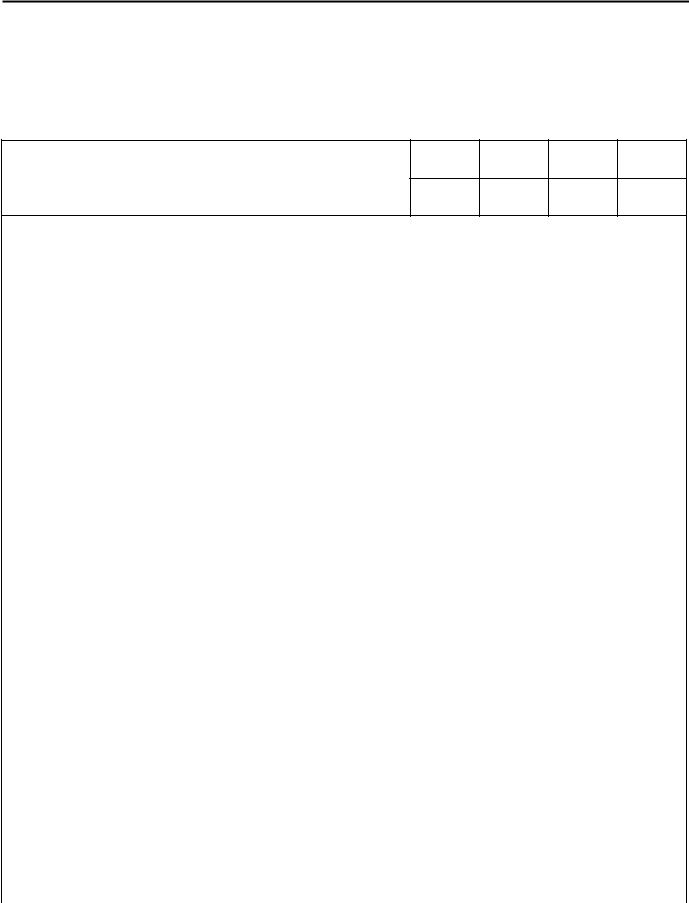
0-20
PERIODIC MAINTENANCE
INSPECTION METHOD
I: Inspection · Repair or Replacement if required M: Measurement · Repair or Adjustment if required T: Retightening C: Cleaning L: Lubrication
*: For new vehicle *1: Flaw detector
|
Inspection timing |
Every |
Every 3 |
Every 6 |
Every 12 |
|
month |
months |
months |
months |
|
|
|
||||
Item |
|
Every |
Every |
Every |
Every |
|
170 hours |
500 hours |
1000 hours |
2000 hours |
|
|
|
ELECTRICAL SYSTEM
|
Rotation sound abnormality |
I |
|
|
|
Motor |
Looseness in the connecting parts |
T |
|
|
|
|
Insulation resistance |
|
M |
|
|
|
|
|
|
|
|
|
Charging level (Display) |
I |
|
|
|
|
Electrolyte level |
I |
|
|
|
|
Electrolyte specific gravity |
M |
|
|
|
Battery |
Looseness in the connecting parts |
I |
|
|
|
Abnormality in the upper portion of the |
|
|
|
|
|
|
I |
|
|
|
|
|
battery and/or the case |
||||
|
|
|
|
|
|
|
Insulation resistance |
|
M |
|
|
|
Voltage measurement of each battery cell |
|
|
|
M |
|
after charging |
|
|
|
|
|
|
|
|
|
|
|
|
|
|
|
|
|
Timer function (Timer test) |
I |
|
|
|
|
Looseness in the connecting parts |
T |
|
|
|
Charger |
HVR function voltage measurement |
|
|
|
M |
|
|
|
|
||
|
Operating condition of the magnetic switch, |
|
|
|
I |
|
contact contamination, roughness |
|
|
|
|
|
|
|
|
|
|
|
|
|
|
|
|
|
Contact looseness, damage, abrasion |
I |
|
|
|
|
Operating condition, contamination and |
I |
|
|
|
|
abrasion of the auxiliary contact |
||||
|
|
|
|
|
|
Magnet switch |
Mounting condition of the arc shooter |
|
|
|
I |
Operating condition and timing |
|
|
|
I |
|
|
|
|
|
||
|
Looseness of the coil installation locations |
|
|
|
I |
|
Mounting condition and looseness of the |
|
|
|
I |
|
main circuit lead wire |
|
|
|
|
|
|
|
|
|
|
|
|
|
|
|
|
|
Operating condition and timing |
I |
|
|
|
Micro switch |
Damage and looseness of installation |
I |
|
|
|
|
|||||
|
locations |
||||
|
|
|
|
|
|
Direction lever |
Operating condition, damage |
I |
|
|
|
|
|
|
|
|
|

|
|
|
|
|
|
|
0-21 |
|
|
|
|
|
|
|
|
|
|
|
|
Inspection timing |
Every |
Every 3 |
Every 6 |
Every 12 |
|
|
|
|
month |
months |
months |
months |
|
||
|
|
|
|
|||||
|
|
|
|
|
|
|
|
|
Item |
|
Every |
Every |
Every |
Every |
|
||
|
170 hours |
500 hours |
1000 hours |
2000 hours |
|
|||
|
|
|
|
|||||
|
|
|
|
|
|
|
|
|
|
|
Operating condition |
I |
|
|
|
|
|
Controller |
|
Interior contamination, damage |
C |
|
|
|
|
|
|
|
Motor input voltage |
|
|
|
|
M |
|
|
|
|
|
|
|
|
|
|
Fuses |
|
Looseness of the installation locations |
I |
|
|
|
|
|
|
|
|
|
|
|
|
|
|
|
|
Harness deterioration, damage and |
I |
|
|
|
|
|
|
|
looseness of the clamp |
|
|||||
Wiring |
|
|
|
|
|
|
|
|
|
Looseness of the connections, taping |
|
|
|
|
|
|
|
(incl. charging |
|
I |
|
|
|
|
||
|
condition |
|
||||||
cable) |
|
|
|
|
|
|
|
|
|
|
|
|
|
|
|
|
|
|
|
Connecting condition and damage of the |
I |
|
|
|
|
|
|
|
battery connector |
|
|||||
|
|
|
|
|
|
|
|
|
|
|
|
|
|
|
|
|
|
POWER TRANSMISSION SYSTEM |
|
|
|
|
|
|
||
|
|
|
|
|
|
|
|
|
|
|
Oil leak |
I |
|
|
|
|
|
Drive unit |
|
Oil level |
I |
|
|
|
|
|
|
|
Bolt or nut looseness |
|
|
|
|
T |
|
|
|
|
|
|
|
|
|
|
DRIVE SYSTEM |
|
|
|
|
|
|
|
|
|
|
|
|
|
|
|
|
|
Front axle |
|
Damage and deformation |
|
|
|
|
I |
|
|
|
|
|
|
|
|
|
|
|
|
Damage and deformation |
|
|
|
|
I |
|
Rear axle |
|
Looseness of rear axle bearing |
|
|
|
|
I |
|
|
|
Abnormal noise of rear axle bearing |
|
|
|
|
I |
|
|
|
|
|
|
|
|
|
|
|
|
Tire pressure |
M |
|
|
|
|
|
|
|
Tire crack, damage and abnormal wear |
I |
|
|
|
|
|
|
|
Tire tread depth |
M |
|
|
|
|
|
|
|
Metal piece, stone and other foreign matter |
I |
|
|
|
|
|
|
|
on tire |
|
|||||
|
|
|
|
|
|
|
|
|
Wheels |
|
Loosening of wheel nut and bolt |
T |
|
|
|
|
|
|
|
|
||||||
|
|
Rim, side ring and disc wheel damage |
I |
|
|
|
|
|
|
|
Looseness and abnormal noise of front |
I |
|
|
|
|
|
|
|
wheel bearing |
|
|||||
|
|
|
|
|
|
|
|
|
|
|
Looseness and abnormal noise of rear |
I |
|
|
|
|
|
|
|
wheel bearing |
|
|
||||
|
|
|
|
|||||
|
|
|
|
|
|
|
|
|
STEERING SYSTEM |
|
|
|
|
|
|
||
|
|
|
|
|
|
|
|
|
Steering wheel |
|
Play, loosening, looseness |
I |
|
|
|
|
|
|
Function |
I |
|
|
|
|
||
|
|
|
||||||
|
|
|
|
|
|
|
|
|
Steering valve |
|
Oil leak |
I |
|
|
|
|
|
|
Looseness of the installation locations |
T |
|
|
|
|
||
|
|
|
||||||
|
|
|
|
|
|
|
|
|
Wheels for |
|
Turning angle to left and right |
|
|
|
|
I |
|
steering |
|
|
|
|
|
|
||
|
|
|
|
|
|
|
|
|
|
|
|
|
|
|
|
|
|

0-22
|
Inspection timing |
Every |
Every 3 |
Every 6 |
Every 12 |
|
|
month |
months |
months |
months |
||
|
|
|||||
|
|
|
|
|
|
|
Item |
|
Every |
Every |
Every |
Every |
|
|
170 hours |
500 hours |
1000 hours |
2000 hours |
||
|
|
|||||
|
|
|
|
|
|
|
|
Oil leak |
I |
|
|
|
|
Power steering |
Looseness of the installation locations |
I |
|
|
|
|
|
Damage of power steering hose |
|
|
|
I |
|
|
|
|
|
|
|
|
BRAKING SYSTEM |
|
|
|
|
||
|
|
|
|
|
|
|
Brake pedal |
Reserve |
M |
|
|
|
|
Braking performance |
I |
|
|
|
||
|
||||||
|
|
|
|
|
|
|
Parking brake |
Operating force and pull margin |
I |
|
|
|
|
Braking performance |
I |
|
|
|
||
|
||||||
|
|
|
|
|
|
|
Rod and cable |
Looseness and damage |
I |
|
|
|
|
Operating condition |
I |
|
|
|
||
|
||||||
|
|
|
|
|
|
|
|
Clearance between disc and pad |
M |
|
|
|
|
|
Wear of sliding portion and pad |
|
|
|
I |
|
Disc brake |
Disc wear and damage |
|
|
|
I |
|
Looseness of the disc installation locations |
|
|
|
I |
||
|
|
|
|
|||
|
Operating condition |
|
|
|
I |
|
|
Return spring fatigue |
|
|
|
I |
|
|
|
|
|
|
|
|
MATERIAL HANDLING SYSTEM |
|
|
|
|
||
|
|
|
|
|
|
|
|
Damage or wear of fork or stopper pin |
I |
|
|
|
|
Fork |
Fork deformation and wear |
I |
|
|
|
|
|
Cracks at fork root and welded part of tooth |
|
|
|
I*1 |
|
|
Deformation and damage of each part and |
I |
|
|
|
|
|
crack at welded part |
|||||
|
|
|
|
|
||
|
Wear and damage of roller |
I |
|
|
|
|
Mast and |
Mast and lift bracket looseness |
I |
|
|
|
|
lift bracket |
Wear and damage of mast support bushing |
|
|
|
I |
|
|
|
|
|
|||
|
Wear and damage of roller pin |
|
|
|
I |
|
|
Wear and damage of mast strip |
I |
|
|
|
|
|
|
|
|
|
|
|
|
Chain lubrication |
I |
|
|
|
|
|
Deformation, damage and slackness of |
I |
|
|
|
|
Chain and |
chain |
|||||
|
|
|
|
|||
chain wheel |
Abnormality of chain anchor bolt |
I |
|
|
|
|
|
||||||
|
Wear, damage and revolution of chain |
I |
|
|
|
|
|
wheel |
|||||
|
|
|
|
|
||
|
|
|
|
|
|
|
Various |
Abnormality and installation condition of |
I |
|
|
|
|
attachments |
each part |
|||||
|
|
|
|
|||
|
|
|
|
|
|
|
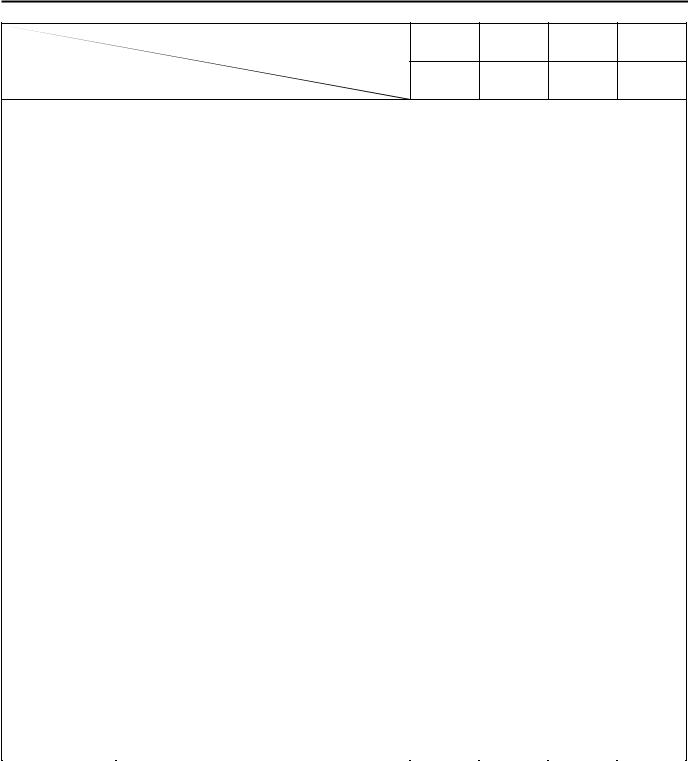
0-23
|
Inspection timing |
Every |
Every 3 |
Every 6 |
Every 12 |
|
month |
months |
months |
months |
|
|
|
||||
Item |
|
Every |
Every |
Every |
Every |
|
170 hours |
500 hours |
1000 hours |
2000 hours |
|
|
|
HYDRAULIC SYSTEM
|
Looseness, deformation and damage of rod |
I |
|
|
|
||
|
and rod end |
||||||
|
|
|
|
|
|
||
|
Cylinder operation |
I |
|
|
|
||
|
Natural drop and natural forward tilt |
M |
|
|
|
||
|
Oil leak and damage |
I |
|
|
|
||
Cylinder |
Wear and damage of pin and cylinder |
I |
|
|
|
||
|
|||||||
|
bearing |
||||||
|
|
|
|
|
|
||
|
Loosening and damage of cylinder |
T |
|
|
|
||
|
mounting |
||||||
|
|
|
|
|
|
||
|
Lifting speed |
M |
|
|
|
||
|
Uneven movement |
I |
|
|
|
||
|
|
|
|
|
|
|
|
Oil pump |
Oil leak and abnormal sound |
I |
|
|
|
||
|
|
|
|
|
|
|
|
|
Oil level and contamination |
I |
|
|
|
||
Hydraulic oil |
Oil leak |
I |
|
|
|
||
tank |
|||||||
|
|
|
|
|
|
||
|
Tank and oil strainer cleaning |
|
|
C |
|
||
|
|
|
|
|
|
|
|
Hydraulic oil |
Filter clogging |
|
|
|
C |
||
filter |
|
|
|
||||
|
|
|
|
|
|
||
|
|
|
|
|
|
|
|
Control lever |
Loose linkage |
I |
|
|
|
||
Operation |
I |
|
|
|
|||
|
|||||||
|
|
|
|
|
|
|
|
|
Oil leak |
I |
|
|
|
||
Oil control |
Safety valve function |
I |
|
|
|
||
valve |
|||||||
|
|
|
|
|
|
||
|
Relief pressure measurement |
|
|
|
M |
||
|
|
|
|
|
|
|
|
Hydraulic hose |
Oil leakage, deformation and damage |
I |
|
|
|
||
and piping |
Looseness |
T |
|
|
|
||
|
|||||||
|
|
|
|
|
|
|
|
SAFETY DEVICES, ETC. |
|
|
|
|
|
||
|
|
|
|
|
|
|
|
|
Looseness of the installation locations |
T |
|
|
|
||
Head guard |
Deformation, crack and damage |
I |
|
|
|
||
and backrest |
|||||||
|
|
|
|
|
|
||
|
Crack at welded portion |
I |
|
|
|
|
|
|
|
||||||
|
|
|
|
|
|
|
|
Lighting system |
Function and installation condition |
I |
|
|
|
|
|
|
|
|
|
|
|
|
|
Direction |
Function and installation condition |
I |
|
|
|
|
|
indicator |
|
||||||
|
|
|
|
|
|
||
Horn |
Function and installation condition |
I |
|
|
|
|
|
|
|
|
|
|
|
|
|
Backup buzzer |
Function and installation condition |
I |
|
|
|
|
|
|
|
|
|
|
|
|
|
Rear view |
Rear reflection status |
I |
|
|
|
|
|
mirror |
Dirt, damage |
I |
|
|
|
|
|
|
|
||||||
|
|
|
|
|
|
|
|

0-24
|
Inspection timing |
Every |
Every 3 |
Every 6 |
Every 12 |
|
month |
months |
months |
months |
|
|
|
||||
|
|
|
|
|
|
Item |
|
Every |
Every |
Every |
Every |
|
170 hours |
500 hours |
1000 hours |
2000 hours |
|
|
|
||||
|
|
|
|
|
|
Instruments |
Operation |
I |
|
|
|
|
|
|
|
|
|
|
Loosening and damage of mounting |
I |
|
|
|
Seat |
Seatbelt damage and function |
I |
|
|
|
|
Deadman seat operation |
I |
|
|
|
|
|
|
|
|
|
|
Damage and cracks in frame, cross mem- |
|
|
|
I |
Body |
bers, etc. |
|
|
|
|
|
|
|
|
||
|
Bolts and nuts looseness |
|
|
|
T |
|
|
|
|
|
|
|
Functions |
I |
|
|
|
|
Loosening and damage at sensor mounting |
I |
|
|
|
|
portion |
||||
|
|
|
|
|
|
SAS |
Damage, deformation, oil leakage and loos- |
I |
|
|
|
|
ened installation of functional parts |
||||
|
|
|
|
|
|
|
Loosening and damage of wire harnesses |
I |
|
|
|
|
Rusting and corrosion of load sensor |
|
|
|
I |
|
|
|
|
|
|
Others |
Grease up |
L |
|
|
|
|
|
|
|
|
|

0-25
PERIODIC REPLACEMENT OF PARTS AND LUBRICANTS
|
|
|
●: Replacement |
||
Replacement cycle |
Every |
Every |
Every |
Every |
|
month |
3 months |
6 months |
12 months |
||
|
|||||
Item |
Every |
Every |
Every |
Every |
|
170 hours |
500 hours |
1000 hours |
2000 hours |
||
|
|||||
Drive unit gear oil |
|
|
● |
|
|
Hydraulic oil |
|
|
● |
|
|
|
● New |
|
|
|
|
Hydraulic oil filter |
vehicle initial |
|
● |
|
|
|
replacement |
|
|
|
|
Rear wheel bearing grease |
|
|
● |
|
|
Power steering hose |
|
|
|
● Every |
|
|
|
|
2 years |
||
|
|
|
|
||
Power steering rubber parts |
|
|
|
● Every |
|
|
|
|
2 years |
||
|
|
|
|
||
Hydraulic hose |
|
|
|
● Every |
|
|
|
|
2 years |
||
|
|
|
|
||
Lift chain |
|
|
|
● Every |
|
|
|
|
3 years |
||
|
|
|
|
||

0-26
1-1
BATTERY
|
Page |
|
BATTERY COMPARTMENT AND |
|
|
REQUIRED WEIGHT ........................................... |
1-2 |
|
|
|
|
SERVICE STANDARDS. . . . . . . . . . . . . . . . . . . . . . . . |
1-3 |
1 |
.....................................................................DISPLAY |
1-3 |
|
TROUBLESHOOTING............................................ |
1-4 |
|
BATTERY ASSY ..................................................... |
1-5 |
|
REMOVAL · INSTALLATION............................................... |
1-5 |
|
INSPECTION .................................................................... |
1-6 |
|
REPLACING BATTERY PLUG TERMINAL..................... |
1-9 |
|
